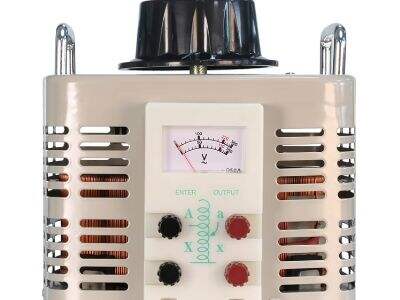மின்னழுத்த ஒழுங்குமுறை அடிப்படைகளுக்கு அறிமுகம்
இது சுற்று பிரண்டம் முழுவதும். _voltage_voltage ஒழுங்குமுறை என்பது சுற்று வழியாக செல்லும் மின்சாரம் நிலையாக இருப்பதை உறுதி செய்வது பற்கும். இது நீங்கள் மிதிவண்டியில் செல்லும்போது தொடர்ந்து ஒரே வேகத்தில் இருக்க விரும்புவதற்கு ஒத்தது — மின்னழுத்த ஒழுங்குபாட்டாளர் மின்சாரம் சீராக ஓடுவதை உறுதி செய்கிறது. மின்னழுத்தம் மிகவும் அதிகமாகவோ அல்லது மிகவும் குறைவாகவோ செல்லும்போது, உங்கள் விளக்குகள் சிமிட்டுவது அல்லது உங்கள் கணினி திடீரென நின்று போவது போன்ற பிரச்சினைகள் ஏற்படலாம்.
மின்னழுத்த ஒழுங்குபாட்டாளரில் என்ன தேடுவது
உங்கள் சுற்றிற்கு மின்னழுத்த ஒழுங்குபடுத்தியைத் தேர்வுசெய்யும்போது, நீங்கள் கருத்தில் கொள்ள வேண்டிய சில காரணிகள் உள்ளன. முதலில், உங்கள் சுற்று எவ்வளவு மின்னாற்றலை தேவைப்படுகிறது என்பதைத் தீர்மானிக்கவும். மின்னழுத்த ஒழுங்குபடுத்திகள் வெவ்வேறு அதிகபட்ச மின்னோட்ட தாங்கும் தன்மை கொண்டவை, எனவே உங்கள் சுற்றுக்குத் தேவையான ஒன்றைத் தேர்வுசெய்ய விரும்புவீர்கள் - இல்லையெனில் அந்த ஒழுங்குபடுத்தி வெப்பமடைந்து செயலிழக்கும்.
அடுத்த கட்டம் நீங்கள் பயன்படுத்த தேர்வுசெய்யும் மின்னழுத்த ஒழுங்குபடுத்தி. சில சுற்றுகள் இடவிசயத்தில் குறுகியதாக இருக்கலாம், எனவே சிறிய ஒழுங்குபடுத்தியை நீங்கள் விரும்பலாம். சில சுற்றுகள் பெரியதாக இருக்கலாம் மற்றும் அனைத்து பாகங்களுக்கும் பொருத்தமான பெரிய ஒழுங்குபடுத்தியை தேவைப்படலாம்.
இறுதியாக, உங்கள் மின்னழுத்த ஒழுங்குபடுத்தியை நீங்கள் எவ்வளவு மின்சார திறன்மிக்கதாக வேண்டும் என்பதைக் கருத்தில் கொள்ளுங்கள். சில ஒழுங்குபடுத்திகள் மற்றவற்றை விட மிகவும் திறமையானவை, எனவே அவை குறைவான மின்சாரத்தை வீணாக்கும். மின்சாரத்தை பாதுகாக்கவும், விஷயங்களை சிறப்பாக இயங்கவும் விரும்பினால், மிகவும் திறமையான ஒழுங்குபடுத்தியை தேர்வுசெய்வது நல்லது.
பயன்பாட்டிற்கு மிகவும் ஏற்ற Voltage Regulator ஐ தேர்வுசெய்தல்
சில வோல்டேஜ் திருத்துபவர் (AVR) ஒவ்வொன்றும் சிறப்பு அம்சங்களை வழங்கும் பல வகைகள் உள்ளன. அத்தகைய ஒரு வகை நேரியல் ஒழுங்குபாட்டாளர் (linear regulator) என அறியப்படுகிறது, இது எளியதும் பயன்படுத்த நேராகவும் உள்ளது. மேலும் சிக்கலான ஸ்விட்சிங் ஒழுங்குபாட்டாளர் (switching regulator) உள்ளது, இது அதிக செயல்திறன் மிக்கதாக இருக்கலாம். உங்கள் சுற்றுக்கு ஏற்றவாறு உங்களால் வெளியீடு மின்னழுத்தத்தை அமைக்க முடியும் சரிசெய்யக்கூடிய ஒழுங்குபாட்டாளர்களும் உள்ளன.
பெரும்பாலான சுற்றுகளுக்கு, நீங்கள் ஒரு விரிவான பணி குதிரை மின்சார வழங்கலை தேவைப்படும் போது, நேரியல் ஒழுங்குபாட்டாளர் சிறந்த தேர்வாக இருக்கும். இது மிகவும் நேரானது மற்றும் மின்னழுத்தத்தை நிலையானதாக மாற்றுவதில் நல்ல பணியைச் செய்கிறது. ஆனால் நீங்கள் மிகவும் செயல்திறன் மிக்க ஒன்றை விரும்பினால், அல்லது வெளியீடு மின்னழுத்தத்தை விருப்பமானதாக மாற்ற வேண்டியிருந்தால், ஸ்விட்சிங் ஒழுங்குபாட்டாளர் சிறந்த தேர்வாக இருக்கலாம். உங்கள் சுற்றின் தேவைகளுக்கு ஏற்ப மின்னழுத்த ஒழுங்குபாட்டாளரின் வகை பொருத்தமானதா இருப்பதை உறுதி செய்யவும்.
உங்கள் சுற்றில் மின்னழுத்தம் ஒழுங்குபடுத்தப்படுவதை உறுதி செய்வது எப்படி
உங்கள் சுற்றில் வழக்கமானவர் தனது பணியைச் செய்வதை உறுதிசெய்ய நீங்கள் சில விஷயங்களைச் செய்யலாம். உங்கள் சுற்றிற்குத் தவறான ஒழுங்குபாட்டாளரைத் தேர்ந்தெடுத்துள்ளீர்களா என்பதைச் சரிபார்த்து அதை உறுதிப்படுத்தவும். நீங்கள் அளவைத் தவறாகத் தேர்ந்தெடுத்தால், மிகவும் பெரியது அல்லது மிகவும் சிறியது, அது சரியாக இயங்காமல் போகலாம்.
பின்னர் உங்கள் சுற்றில் ஒழுங்குபாட்டாளரை இணைக்கும் வழி உள்ளது. தயாரிப்பாளரின் வழிமுறைகளைப் பின்பற்ற மிகவும் கவனமாக இருங்கள். மேலும், உங்கள் சுற்றில் உள்ள பிற பாகங்களால் ஒழுங்குபாட்டாளர் தொந்தரவு செய்யப்படாமல் அதை ஏற்பாடு செய்ய வேண்டும்.
இறுதியாக உங்கள் வோல்டேஜ் ரிஜுலேடர் சரியாக செயல்படுகிறது, உங்கள் சுற்றை சோதனை செய்யவும். உங்கள் சுற்றின் பல்வேறு பகுதிகளில் மின்னழுத்தத்தை ஒரு ஜோடி பல்மீட்டர் பொருகளுடன் அளவிடவும், அது மாறிலியாக இருக்க வேண்டும். உங்களுக்கு வேறுபட்ட படிகள் தெரிந்தால், அந்நியூனத்தை சரிசெய்ய உங்கள் ஒழுங்குபாட்டாளர் மற்றும் இணைப்புகளை மீண்டும் சரிபார்க்க வேண்டும்.
மின்னழுத்த ஒழுங்குபாட்டாளரைத் தேர்ந்தெடுக்கும் போது செய்யப்படும் பொதுவான பிழைகள்
மின்வழிப்பாதுகாப்பாளரைத் தேர்ந்தெடுக்கும்போது எச்சரிக்கையாக இருக்க வேண்டிய பல தவறுகள் உள்ளன. ஒரு முக்கியமான தவறு, உங்கள் சுற்றுமின்னோட்டத்தின் மின்சார நுகர்வை கணக்கில் எடுத்துக்கொள்ளாமை ஆகும். உங்கள் சுற்றுமின்னோட்டத்திற்குத் தேவையான மின்சாரத்தை வழங்க முடியாத ஒரு மின்வழிப்பாதுகாப்பாளரைத் தேர்ந்தெடுத்தால், அது தவறாக இயங்கும்.
இரண்டாவது தவறு மின்வழிப்பாதுகாப்பாளரின் அளவைக் கணக்கில் கொள்ளாமை ஆகும். உங்கள் சுற்றுமின்னோட்டத்திற்கு அது மிகவும் பெரியதாகவோ அல்லது மிகச்சிறியதாகவோ இருந்தால், அது பொருத்தம் அல்லது செயல்திறன் சிக்கல்களை ஏற்படுத்துமா? மின்வழிப்பாதுகாப்பாளரைத் தேர்ந்தெடுக்கும் முன் உங்கள் சுற்றுமின்னோட்டத்தில் உள்ள இடத்தை ஒப்பிட்டுப் பார்த்துக்கொள்ளுங்கள்.
இறுதியாக், உங்கள் மின்வழிப்பாதுகாப்பாளரில் செயல்திறன் இழப்பைக் கணக்கில் கொள்ளுங்கள். நீங்கள் தேர்ந்தெடுக்கும் மின்வழிப்பாதுகாப்பாளர் அதிக செயல்திறன் இல்லாததாக இருந்தால், அது மின்சாரத்தை வீணாக்கி, உங்கள் சுற்றுமின்னோட்டம் சரியாக இயங்காமல் போகலாம். அனைத்தும் சரியாக (மற்றும் ஆற்றல் செயல்திறனுடன்) இயங்குவதை உறுதிசெய்ய, செயல்திறன் மிக்கதாக பெயர் பெற்ற மின்வழிப்பாதுகாப்பாளர்களைத் தேடவும்.
உள்ளடக்கப் பட்டியல்
- மின்னழுத்த ஒழுங்குமுறை அடிப்படைகளுக்கு அறிமுகம்
- மின்னழுத்த ஒழுங்குபாட்டாளரில் என்ன தேடுவது
- பயன்பாட்டிற்கு மிகவும் ஏற்ற Voltage Regulator ஐ தேர்வுசெய்தல்
- உங்கள் சுற்றில் மின்னழுத்தம் ஒழுங்குபடுத்தப்படுவதை உறுதி செய்வது எப்படி
- மின்னழுத்த ஒழுங்குபாட்டாளரைத் தேர்ந்தெடுக்கும் போது செய்யப்படும் பொதுவான பிழைகள்
 EN
EN
 AR
AR
 FR
FR
 EL
EL
 HI
HI
 PT
PT
 RU
RU
 ES
ES
 TL
TL
 ID
ID
 UK
UK
 VI
VI
 TH
TH
 TR
TR
 FA
FA
 MS
MS
 AZ
AZ
 KA
KA
 UR
UR
 BN
BN
 GU
GU
 HA
HA
 IG
IG
 KM
KM
 LO
LO
 LA
LA
 MR
MR
 MN
MN
 NE
NE
 SO
SO
 TA
TA
 YO
YO
 ZU
ZU
 MY
MY
 KK
KK
 MG
MG
 KU
KU
 KY
KY
 SD
SD

